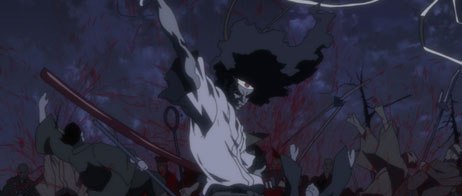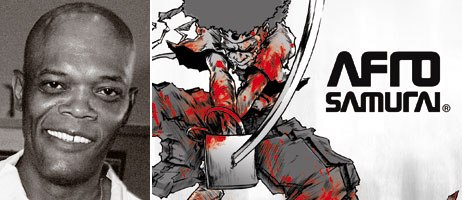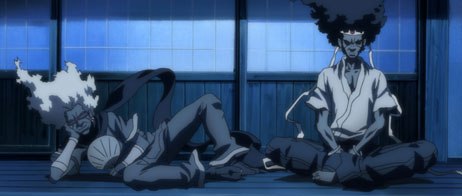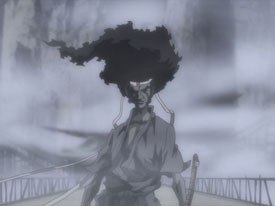Joe Strike looks into the production of Studio Gonzo's Afro Samurai, which mixes anime action with a hip-hop flavor.

Afro Samurai has been a self-published magazine, a toy, a video and a concept before it became a miniseries. All images Spike TV © 2006 Takashi Okazaki, Gonzo/Samurai Project. Licensed by FUNimation®.
The mountains of manga -- that's Japanese comics to you, gaijin -- produced every year have inspired no small number of anime TV series and full-length features, few of which make it to American shores. Usually it's the high profile, top-selling properties that get the multi-media treatment, not self-published fan efforts.
But not always.
Graphic designer Takashi (or as he calls himself, "Bob") Okazaki was still a student at Tama Art University when the image of a large-haired, black-skinned and vengeance-driven samurai warrior -- Afro Samurai -- first came to him. In today's Internet-fueled, mixmaster world culture, influences run every which way: from east to west (bringing anime and manga to the U.S.) and vice-versa, turning college kids like Okazaki onto hip hop music, Soul Train reruns and blaxploitation flicks.
Fame and fortune did not follow, at least not right away. Okazaki created a six-page Afro Samurai adventure and self-published it in a limited print-run magazine funded by himself and friends -- an effort that was greeted with instant indifference.

Graphic designer Takashi Okazaki won a contest to produce a toy figure of Afro Samurai, which caught the eye of GDH's Eric Calderon. It has taken five years to develop the concept for U.S. TV.
Afro's next go-round proved more fortunate, when Okazaki won a contest to produce a toy figure of his character. Only a few thousand were created, one of which wound up on the desk of a producer at Japan's Studio Gonzo animation house. The glowering samurai caught the eye of Eric Calderon, vp of creative affairs for Gonzo's parent company GDH International. Calderon, who spent a good part of the 1990s at MTV Animation, had been hired in 2001 by GDH to help the anime studio's shows penetrate the U.S. market. With sales to Adult Swim (Trinity Blood), IFC (Samurai 7) and G4 (Last Exile) Calderon was doing his job well, but Gonzo also wanted to do "fusion" animation -- co-productions with western companies.
Calderon "asked the producer about the toy. He told me the character was really cool, but the guy who made it was too shy to meet people. I pushed and pushed and eventually he met with me."
After meeting Okazaki, Calderon quickly decided to develop Afro Samurai for U.S. television, and not a Japanese show that would be post-dubbed into English. It was the beginning of what Calderon describes as "a long haul" -- one lasting half a decade, leading up to this week when Afro Samurai premieres on Spike TV as a five-episode mini-series.
Calderon convinced GDH to make a three-minute presentation video based on little more than the basic concept of the character, then gave home-burned DVD copies of it to friends in the L.A entertainment community. "Sam, you have to see this," said one of the recipients, an agent at the powerhouse ICM talent agency. The Sam in question was Samuel L. Jackson, who happened to be passing by his office. Even though the agent didn't rep Jackson, he suspected the video might pique the feisty star's interest.
That it did. According to Calderon, Jackson, "stole the DVD from the agent by force and started calling around town. He said, 'I am going to be Afro Samurai.' We said, 'Okay'."
One does not risk saying no to Samuel L. Jackson, especially when his name alone can -- at the very least -- guarantee doors will open to hear a pitch for an otherwise unknown property. Jackson was on board as Afro's voice and as an executive producer; Afro Samurai now had an enormous leg up on the competition.
"For the next eight months we were wined and dined," Calderon recalls. "Everyone thought Afro Samurai was going to be a movie, a videogame, a comicbook or a toy line. We started pitching the project before we knew what final form it would take," he confesses. "We weren't sure what to do with it -- there were tons of formats thrown around."
One of the parties pitched by Calderon was Leo Chu, the exec in charge of animation for Spike, the testosterone-fueled cable channel. Chu had come out of Disney where he was the exec producer on the American release of Miyazaki's Spirited Away and was no stranger to anime himself.
"I was very impressed," Chu acknowledges, "but there was no story per se when we started -- just a lot of potential. You discover a lot about animation as you flesh out a story, board it and create character designs. We just got behind it and went into story meetings."
The chemistry between Gonzo and Spike was perfect. The successor to the short-lived National Network (which itself had replaced the Nashville Network), Spike was in the process of redefining its original vague identity into a men's action channel -- and even though Afro Samurai was still in its formative stages, everyone recognized a good fit when they saw one. Chu and Calderon both credit Doug Herzog, president of MTV Networks for giving Spike the greenlight to develop the project without watering it down.
An old joke describes a camel as a horse designed by a committee; in hindsight it's either a miracle or brilliant intuition on everyone's part that Afro Samurai emerged from development as a sleek predator and not a three-humped dromedary.

A short presentation video excited Samuel L. Jackson, who came on as voice actor and exec producer. His producer credit wasn't just vanity; he was at every story meeting and gave extensive notes.
The process began with an English language outline of the show's basic premise: a warrior searching through a barren landscape -- equal parts spaghetti western, feudal Japan and post-apocalypse wasteland -- for the man who killed his father. Two Japanese writers began putting meat on the story's bones, communicating with their American partners via translators.
"There were always a lot of pauses and breaks during the story meetings because everyone was speaking through translators," remembers Chu. "It was funny when you got mistranslated -- something Sam or I said didn't come across, or something they said got misunderstood as something else.
"Sam, to his credit, came to all the story meetings. He had notes and thoughts; he read everything and had strong opinions about what character should be doing." Once a script had been cooked up to everyone's satisfaction, a final, born in the U.S. script was handed off to Japanese storyboard artists -- who according to Calderon, "changed about 60% of the story. The show was animated to the boards. Once we looked at the animation we had to go back and rewrite most the dialog."
"Because of the collaboration we came up with something that feels unique," Chu says. "I don't think this was too many cooks spoiling the broth -- in this case all the cooks had something really strong to contribute. We ended up forging something out of the original property that we wouldn't have achieved same result if it were just made in the U.S. or Japan." Calderon describes the end result not as "east meets west. We were going for, and we got everyone to buy into something that was 85% Japanese and 15% freestyle."
Afro Samurai can't quite claim credit as being the first samurai/hip-hop crossover. That honor may go to Samurai Champloo, a 2004 anime series that aired on Adult Swim a year later, or even Kung Faux -- a goofball, Tiger Lily-type redubbing of chop-socky flicks with inner-city voices shown on the fuse music video channel in 2003. Afro, however is the most ambitious (and visually exciting) effort to date.

Because Afro Samurai's character is taciturn, Jackson realized he would have very few lines in each episode. He jumped at the chance to also voice Ninja Ninja (left), the comedic sidekick.
An all but monochromatic, shades-of-granite color scheme underscores Afro's grim quest for his father's assassin; the occasional touches of color (like a pale yellow glass of lemonade in a dank tavern) stand out all the more as a result. Another color appears far more frequently -- generous washes of red as combatants regularly slice, dice and behead one another. (Not eye, but "blood candy" is the term Chu uses to describe the action.) The world is populated by gnarled and angular, narrow-eyed figures -- no wide-eyed anime kewpie dolls here.
The mix of swords and cell phones can throw a viewer for a loop the first time one of Afro's adversaries pulls out a humongous grenade launcher to take him down, but quickly becomes a part of the show's appeal -- along with a moaning-and-groaning sex scene here and there.
The show's music is courtesy of hip-hop artist RZA, the founder of the seminal Wu-Tang Clan and Quentin Tarantino's composer for Kill Bill among a slew of other films. "It feels like the music speaks for Afro Samurai," says Chu. Like Clint Eastwood in Fistful of Dollars, Afro's "a man of few words -- one reason why Sam plays two characters." Afro is accompanied (and/or pestered) on his quest by Ninja Ninja, Afro's fast-talking sidekick and one-man Greek chorus.
"Early on in the story meetings Sam said, 'Wait a second, I need to play Ninja Ninja,'" Chu recalls, "'otherwise I'll only have four lines.' Ninja Ninja is the type of character Sam doesn't get to play in live action. If you're casting a squirrelly comedic sidekick, I don't know if you'd think of Sam Jackson for the role. He got to flex his acting muscles on the character."
The two other voice performers highlighting the series are Kelly Hu, who battled Hugh Jackman in X2, and Ron Perlman as Afro's nemesis Number One, aka "Justice." "This one just fell out of the heavens and into my lap," Perlman says, his enthusiasm clearly showing. "I heard who was involved and immediately got excited. The project had Sam's imprint on it, that was the first thing. Then I looked at the visuals, what the animators were doing and the excitement just built."

Afro Samurai can't quite claim credit as being the first samurai/hip hop crossover, but it is the most ambitious and visually exciting effort to date.
Perlman considers himself an anime enthusiast, via his friend and Hellboy director Guillermo del Toro, who passed the bug onto Perlman's son Brandon. "I get it more through my boy than anything else -- he's been to Japan four times already."
Perlman, who's played numerous larger-than-life (and more-than-human) characters onscreen, is no stranger to animation; he's done voice work on shows ranging from Teen Titans to Hey Arnold!, as well as the recent animated Hellboy video, Sword of Storms. "It's an instinctive process I really enjoy," he says. "It's very results-oriented, primal. There's no rehearsal, no prolonged discovery process. It's a way of trusting your instruments." When it's remarked that he doesn't have to spend four hours in makeup before filming begins, Perlman responds, "you don't even have to wear pants."
Afro Samurai is set to premiere Jan. 4, 2007, on Spike, with an online New Year's Eve run on the channel's website. Depending on its reception, future minis will follow, each one a chapter (and each episode a sub-chapter) in Afro's ongoing story. A live-action version starring Jackson is also in the works, currently in development at Mosaic Media by producers Charles Roven (Batman Begins) and Alex Gartner (Barbershop 2). Right off the bat, however, Spike's Afro Samurai takes the channel in a gutsier direction than its last stab at animated programming, shows like Ren & Stimpy or Stripperella.
"Animation has such a unique way of setting tone for what a new network can be," Chu maintains. "Those shows set the tone for what Spike was then -- this is what Spike is now. The Simpsons embodied FOX in the late '80s and they followed with Married with Children... and other comedies -- that became FOX. Comedy Central didn't really break through until South Park -- suddenly that created the tone for the network. We're hoping Afro Samurai does the same thing for us -- galvanize what the new Spike is.
"It takes a lot of stars to align for something new to get made," he reflects. "The enthusiasm from GDH and Spike were part of it. But having a major movie star like Samuel L Jackson wanting to play the character, on board as a producer and so supportive of it every step of the way, made it feel like a legitimate show with credibility, as opposed to a bunch of animation guys trying to make something cool."
Joe Strike is a regular contributor to AWN. His animation articles also appear in the NY Daily News and the New York Press.







